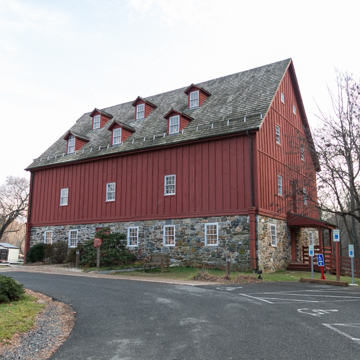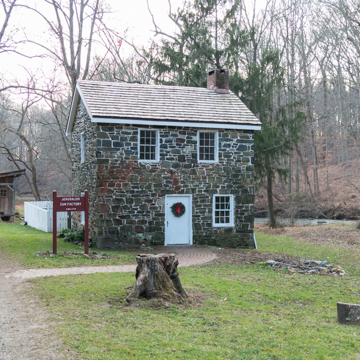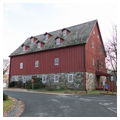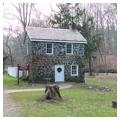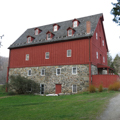Designed and built by miller David Lee and millwright Isaiah Linton, Jerusalem is the only remaining milling complex within this area erected during the era of early industrialization. Built to take advantage of the flour export trade through the port of Baltimore, Jerusalem Mill is indicative of the transformation occurring at the hands of early entrepreneurs during America’s Industrial Revolution. Lee was a Quaker who migrated from Bucks County, Pennsylvania. By 1814, the site encompassed a flour mill, sawmill, blacksmith and coopers’ shops, general store and post office, residences, and other support structures.
The mill is a massive heavy-timber-frame structure on a stone ground floor, with upper stories sheathed in board and batten and a steeply pitched gable roof with uncommon tiered dormers. While much of the interior framing and equipment date to the nineteenth century, it operated as a water-powered mill until 1961. It was then purchased by the Maryland Department of Natural Resources as part of Gunpowder Falls State Park. A restoration by the Friends of Jerusalem Mill began in 1987, providing a rare opportunity to view the workings of a self-sufficient mill village.
References
Hnedak, John, “Jerusalem Mill (and Associated Structures),” Harford County, Maryland. National Register of Historic Places Inventory–Nomination Form, (undated). National Park Service, U.S. Department of the Interior, Washington, D.C.
McGrain, John W. Grist Mills in Baltimore County. Baltimore County, Maryland: A Baltimore County Heritage Publication, 1980.
Penrod, Paul L., “Jerusalem Mill and Outbuildings,” Harford County, Maryland. National Register of Historic Places Inventory–Nomination Form, 1976. National Park Service, U.S. Department of the Interior, Washington, D.C.
Weeks, Christopher et al. An Architectural History of Harford County, Maryland. Baltimore: Johns Hopkins University Press, 1986.
Weeks, Christopher et al. “Jerusalem Mill Village,” Harford County, Maryland. National Register of Historic Places Inventory–Nomination Form, 1986. National Park Service, U.S. Department of the Interior, Washington, D.C.


